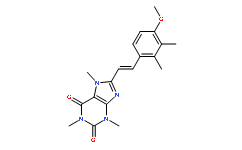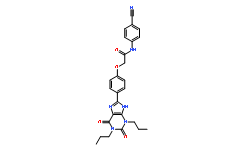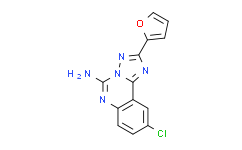| 中文名称: | KF21213 | ||||
|---|---|---|---|---|---|
| 英文名称: | KF21213 | ||||
| CAS No: | 155271-17-3 | 分子式: | C19H22N4O3 | 分子量: | 354.4 |
| CAS No: | 155271-17-3 | ||||
| 分子式: | C19H22N4O3 | ||||
| 分子量: | 354.4 | ||||
基本信息
|
产品编号: |
K10114 |
||||
|
产品名称: |
KF21213 |
||||
|
CAS: |
155271-17-3 |
储存条件 |
粉末 |
-20℃ |
四年 |
|
分子式: |
溶于液体 |
-80℃ |
二年 |
||
|
分子量: |
354.40 |
|
|
||
|
化学名: |
1H-Purine-2,6-dione,3,7-dihydro-8-(2-(2,3-dimethyl-4-methoxyphenyl)ethenyl)-1,3,7-trimethyl-,(E)- |
||||
|
Solubility (25°C): |
|||||
|
体外:
|
DMSO |
|
|||
|
Ethanol |
|
||||
|
Water |
|
||||
|
体内(现配现用): |
|
||||
|
<1mg/ml表示微溶或不溶。 |
|||||
|
普西唐提供的所有化合物浓度为内部测试所得,实际溶液度可能与公布值有所偏差,属于正常的批间细微差异现象。 |
|||||
|
请根据产品在不同溶剂中的溶解度选择合适的溶剂配制储备液;⼀旦配成溶液,请分装保存,避免反复冻融造成的产品失效。 |
|||||
生物活性
|
产品描述 |
高选择性地结合到腺苷 A2A 受体,Ki 值为 3.0nM。 |
|
靶点 |
Ki:3.0nM (A2A receptor) |
|
体外研究 |
[11C]KF21213 as a PET ligand for mapping adenosine A2A receptors in the central nervous system (CNS).KF21213 shows a high affinity for the adenosine A2A receptors in vitro (Ki=3.0nM) and a very low affinity for the A1 receptors (Ki>10,000nM). |
|
体内研究 |
The uptake of [11C]KF21213 by the striatum gradually increases for the first 15 min and then decreases.The uptake by the cortex and cerebellum is rapidly decreased after injection.Their levels are compatible with that in the blood.Consequently,the uptake ratios of striatum to cortex and striatum to cerebellum increases up to 8.6±1.6 and 10.5±2.1 (N=4),respectively,by 60 min.The striatal activity level of [11C]KF21213 is retained for the initial 5 min and then gradually decreased with time,whereas that of [11C]KF18446 rapidly decreases.The cerebellar activity of the two ligands rapidly decreases.The striatum-tocerebellum uptake ratio for [11C]KF21213 gradually increases to 2.4 6 0.5 (N 5 3) by 50-60 min,whereas that for [11C]KF18446 increases for the first 10 min and remains constant (1.4±0.3,N=3,at 25-35 min). |
推荐实验方法(仅供参考)
|
激酶实验: |
|
The in vitro affinity of KF21213 for the adenosine A2A and A1 receptors is determined using the rat striatal membrane and [3H]CGS 21680 as a radioligand and the rat forebrain membrane and N6-[3H]cyclohexyladenosine,respectively.The assay is performed in the dark to prevent photo-isomerization. |
|
细胞实验: |
|
|
Mice Two groups of male ddY mice (30-39g) are used.In the first group,[11C]KF21213 (1.1 MBq/36 pmol) is intravenously injected.They are killed by cervical dislocation at 5,15,30,and 60 min after injection (N=4 each).Blood is collected by heart puncture.The brain is removed and dissected into the striatum,cortex,and cerebellum.The regional brain uptake of radioactivity is measured as the percentage of injected dose per gram tissue (%ID/g).In the other group,[11C]KF21213 (1.1 MBq/21 pmol) is co-injected with one of the following adenosine receptor antagonists:A2A antagonists KF21213,KF17837,KF18446,and SCH 58261 and an A1 antagonist KF15372.The injected dose of KF21213 is 30nmol and that of other antagonists is 50nmol.The mice are killed at 15 min after injection (N=9 for control and N=4 for each of the other groups).The regional brain uptake of radioactivity is measured. Rat PET measurement is performed in three rats with a model SHR-2000 camera with Z=2 mode,providing 14 slices at 3.25mm intervals.The rat (240-300g) is anesthetized with 0.02% isoflurane throughout the PET study.The anesthetized rat is positioned prone on a stereotaxic head holder made of polymethyl methacrylate.An incision is made on the scalp to locate the bregma,which is positioned at the tenth slice from caudal.After a transmission scan to correct for photon attenuation,the [11C]KF21213 (N=3) (43–56 MBq/1.2-1.9nmol/kg body weight) or [11C]KF18446 (N=3) (50-55 MBq/1.8-4.9nmol/kg body weight) is injected through the tail vein,and the time sequential tomographic scanning is performed for 60 min (20 frames by 30 sec and 50 frames by 1 min). |
|
本计算器可帮助您计算出特定溶液中溶质的质量、溶液浓度和体积之间的关系,公式为:
质量 (g) = 浓度 (mol/L) x 体积 (L) x 分子量 (g/mol)
摩尔浓度计算公式
用本工具协助配置特定浓度的溶液,使用的计算公式为:
开始浓度 x 开始体积 = 最终浓度 x 最终体积
稀释公式
稀释公式一般简略地表示为:C1V1 = C2V2 ( 输入 输出 )










